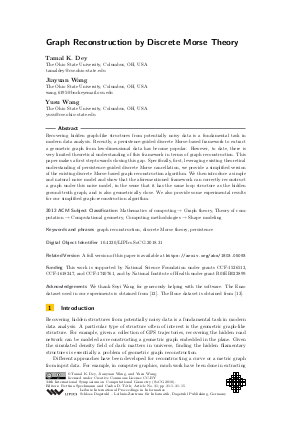Graph Reconstruction by Discrete Morse Theory
Authors Tamal K. Dey, Jiayuan Wang, Yusu Wang
-
Part of:
Volume:
34th International Symposium on Computational Geometry (SoCG 2018)
Part of: Series: Leibniz International Proceedings in Informatics (LIPIcs)
Part of: Conference: Symposium on Computational Geometry (SoCG) - License:
 Creative Commons Attribution 3.0 Unported license
Creative Commons Attribution 3.0 Unported license
- Publication Date: 2018-06-08
File

PDF
LIPIcs.SoCG.2018.31.pdf
- Filesize: 1.47 MB
- 15 pages
Document Identifiers
Subject Classification
Keywords
- graph reconstruction
- discrete Morse theory
- persistence
Metrics
- Access Statistics
-
Total Accesses (updated on a weekly basis)
0Document
0Metadata
Abstract
Recovering hidden graph-like structures from potentially noisy data is a fundamental task in modern data analysis. Recently, a persistence-guided discrete Morse-based framework to extract a geometric graph from low-dimensional data has become popular. However, to date, there is very limited theoretical understanding of this framework in terms of graph reconstruction. This paper makes a first step towards closing this gap. Specifically, first, leveraging existing theoretical understanding of persistence-guided discrete Morse cancellation, we provide a simplified version of the existing discrete Morse-based graph reconstruction algorithm. We then introduce a simple and natural noise model and show that the aforementioned framework can correctly reconstruct a graph under this noise model, in the sense that it has the same loop structure as the hidden ground-truth graph, and is also geometrically close. We also provide some experimental results for our simplified graph-reconstruction algorithm.
Cite As Get BibTex
Tamal K. Dey, Jiayuan Wang, and Yusu Wang. Graph Reconstruction by Discrete Morse Theory. In 34th International Symposium on Computational Geometry (SoCG 2018). Leibniz International Proceedings in Informatics (LIPIcs), Volume 99, pp. 31:1-31:15, Schloss Dagstuhl – Leibniz-Zentrum für Informatik (2018)
https://doi.org/10.4230/LIPIcs.SoCG.2018.31
BibTex
@InProceedings{dey_et_al:LIPIcs.SoCG.2018.31,
author = {Dey, Tamal K. and Wang, Jiayuan and Wang, Yusu},
title = {{Graph Reconstruction by Discrete Morse Theory}},
booktitle = {34th International Symposium on Computational Geometry (SoCG 2018)},
pages = {31:1--31:15},
series = {Leibniz International Proceedings in Informatics (LIPIcs)},
ISBN = {978-3-95977-066-8},
ISSN = {1868-8969},
year = {2018},
volume = {99},
editor = {Speckmann, Bettina and T\'{o}th, Csaba D.},
publisher = {Schloss Dagstuhl -- Leibniz-Zentrum f{\"u}r Informatik},
address = {Dagstuhl, Germany},
URL = {https://drops.dagstuhl.de/entities/document/10.4230/LIPIcs.SoCG.2018.31},
URN = {urn:nbn:de:0030-drops-87443},
doi = {10.4230/LIPIcs.SoCG.2018.31},
annote = {Keywords: graph reconstruction, discrete Morse theory, persistence}
}
Author Details
References
-
M. Aanjaneya, F. Chazal, D. Chen, M. Glisse, L. Guibas, and D. Morozov. Metric graph reconstruction from noisy data. International Journal of Computational Geometry &Applications, 22(04):305-325, 2012.

-
D. Attali, M. Glisse, S. Hornus, F. Lazarus, and D. Morozov. Persistence-sensitive simplification of functions on surfaces in linear time. Presented at TOPOINVIS, 9:23-24, 2009.

-
U. Bauer, C. Lange, and M. Wardetzky. Optimal topological simplification of discrete functions on surfaces. Discr. Comput. Geom., 47(2):347-377, 2012.

-
S. Biasotti, D. Giorgi, M. Spagnuolo, and B. Falcidieno. Reeb graphs for shape analysis and applications. Theoretical Computer Science, 392(1-3):5-22, 2008.

-
F. Chazal, R. Huang, and J. Sun. Gromov-hausdorff approximation of filamentary structures using reeb-type graphs. Discr. Comput. Geom., 53(3):621-649, 2015.

-
O. Delgado-Friedrichs, V. Robins, and A. Sheppard. Skeletonization and partitioning of digital images using discrete morse theory. IEEE Trans. Pattern Anal. Machine Intelligence, 37(3):654-666, March 2015.

-
T. Dey and J. Sun. Defining and computing curve-skeletons with medial geodesic function. In Sympos. Geom. Proc., volume 6, pages 143-152, 2006.

-
T. Dey, J. Wang, and Y. Wang. Improved road network reconstruction using discrete morse theory. In Proc. 25th ACM SIGSPATIAL. ACM, 2017.

-
T. Dey, J. Wang, and Y. Wang. Graph reconstruction by discrete morse theory. arXiv preprint arXiv:1803.05093, 2018.

- H. Edelsbrunner and J. Harer. Computational Topology - an Introduction. American Mathematical Soc., 2010. URL: http://www.ams.org/bookstore-getitem/item=MBK-69.
-
H. Edelsbrunner, D. Letscher, and A. Zomorodian. Topological persistence and simplification. Discr. Comput. Geom., 28:511-533, 2002.

- The ENZO project. URL: http://enzo-project.org.
- The Center for Integrative Biomedical Computing (CIBC). Micro-CT Dataset Archive. URL: https://www.sci.utah.edu/cibc-software/cibc-datasets.html.
-
R. Forman. Morse theory for cell complexes. Advances in mathematics, 134(1):90-145, 1998.

-
X. Ge, I. I Safa, M. Belkin, and Y. Wang. Data skeletonization via reeb graphs. In Advances in Neural Info. Proc. Sys., pages 837-845, 2011.

-
A. Gyulassy, M. Duchaineau, V. Natarajan, V. Pascucci, E. Bringa, A. Higginbotham, and B. Hamann. Topologically clean distance fields. IEEE Trans. Visualization Computer Graphics, 13(6):1432-1439, Nov 2007.

-
T. Hastie and W. Stuetzle. Principal curves. Journal of the American Statistical Association, 84(406):502-516, 1989.

-
B. Kégl and A. Krzyzak. Piecewise linear skeletonization using principal curves. IEEE Trans. Pattern Anal. Machine Intelligence, 24(1):59-74, 2002.

-
L. Liu, E. W Chambers, D. Letscher, and T. Ju. Extended grassfire transform on medial axes of 2d shapes. Computer-Aided Design, 43(11):1496-1505, 2011.

-
J. Milnor. Morse Theory. Princeton Univ. Press, New Jersey, 1963.

-
M. Natali, S. Biasotti, G. Patanè, and B. Falcidieno. Graph-based representations of point clouds. Graphical Models, 73(5):151-164, 2011.

-
U. Ozertem and D. Erdogmus. Locally defined principal curves and surfaces. Journal of Machine learning research, 12(Apr):1249-1286, 2011.

-
V. Robins, P. J. Wood, and A. P. Sheppard. Theory and algorithms for constructing discrete morse complexes from grayscale digital images. IEEE Trans. Pattern Anal. Machine Intelligence, 33(8):1646-1658, Aug 2011.

-
T. Sousbie. The persistent cosmic web and its filamentary structure-i. theory and implementation. Monthly Notices of the Royal Astronomical Society, 414(1):350-383, 2011.

-
S. Wang, Y. Wang, and Y. Li. Efficient map reconstruction and augmentation via topological methods. In Proc. 23rd ACM SIGSPATIAL, page 25. ACM, 2015.

-
Y. Yan, K. Sykes, E. Chambers, D. Letscher, and T. Ju. Erosion thickness on medial axes of 3d shapes. ACM Trans. on Graphics, 35(4):38, 2016.

